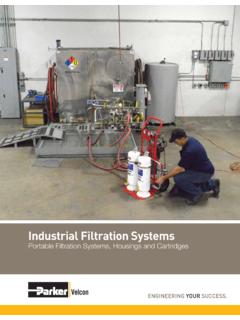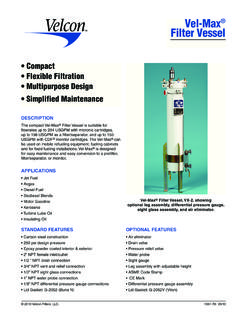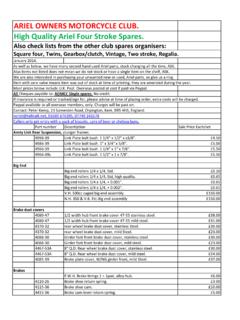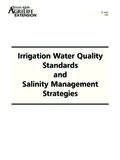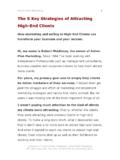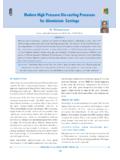Transcription of Clay Treatment of Fuel – Critical to the Delivery of High ...
1 clay Treatment of fuel Critical to the Delivery of high quality fuel Greg Sprenger & Rob Perkins, Velcon Filters, Inc. Background Clean, dry fuel has been assured for decades by using filter/separators containing coalescer cartridges. These remove water by coalescing the small water droplets, generated by pumps, into large drops which can settle in filter/separator housings. Critical to this process is controlling the level of surfactants in the fuel . clay treaters remove surfactants and allow coalescers to perform their function. In recent years, coalescer development has strived to provide coalescers which are more tolerant of these surfactants in the form of additives. However clay treaters still play a major role in assuring the Delivery of clean, dry fuel . Surfactants Surfactants, or surface active agents, are chemical compounds present in the fuel which are attracted to surfaces and interfaces.
2 These polar compounds move to the interface of fuel and water, and disrupt the coalescing process. These can be present in the fuel from refinery carry over or from cross-contamination in multi-product pipelines. Multi-product pipelines fuel is transported in the US primarily by multi-product pipelines. These pipelines carry gasoline, diesel fuel , and jet fuel . Historically, diesel fuel was the lowest grade fuel and contained surfactants routinely. These surfactants attached to pipeline pipe walls, and then transferred into subsequent jet fuel batches traveling down the pipeline. This is called tailback . This contaminated jet fuel then had to be clay treated at Delivery to remove these surfactants. Recently, the introduction of low sulfur diesel fuel has changed this dynamic a bit. The process to remove sulfur from diesel fuel , hydrotreating, is the same process used to remove surfactants from jet fuel .
3 So now, low sulfur diesel fuel is as surfactant-free or better than jet fuel . However, counteracting this positive trend is the introduction of alternate fuels, such as bio-derived fuels. The chemistry of these 2008 Velcon Filters, Inc. Page 1 of 3. fuels can be highly surface-active. These are now finding their way into multi-product pipelines, resulting in the same cross-contamination issues. clay characteristics Surfactants are attracted to surfaces. Surfactants strongly stick to clay surfaces. clay is used in the form of a fine sand, providing lots of surface area to hold the surfactants. A typical 60/90 clay has approximately 13 acres of surface per pound of clay . This is due to the jagged, irregular, and somewhat porous surface of the clay particles. Velcon has used a 60/90 mesh clay for decades. Other suppliers use a coarser 30/60 mesh product.
4 Lab tests show that the capacity for surfactants is about 2x higher for the finer 60/90 mesh material. Attapulgus LVM clay is normally used, which is better able to withstand water exposure without crumbling to a powder material. clay filter cartridges clay cartridges are sold in 2 forms; bags and canisters. Both flow outside to inside. Bags are cloth structures, which hold the clay with little structure. They are normally stacked in the clay treater. Stacking bags can lead to bypassing, since they have little structure and no gaskets are present between the bags when stacked. Velcon recommends canisters, which have metal end caps and gaskets. They seal much like a normal filter, providing leak-free seals. clay canisters for jet fuel service are approximately 7 diameter x 18 long. They are rated to flow 6-7 gpm per cartridge. This is a compromise between providing sufficient residence time for the efficient removal of surfactants onto the clay , and economics.
5 clay filter vessel operation clay treaters are typically used in a system with other filter vessels. Normally a string of 3 vessels is used for receipt of jet fuel from pipelines; prefilter, clay treater, and filter/separator. This provides particle, surfactant, and water removal before taking the fuel into airport. clay cartridges have a finite capacity for surfactants. This useful life is poorly tracked by users. Most are changed out by time, even though many are not functioning. One measure of surfactant level is an MSEP test (ASTM D4860), with a reading of 100. 2008 Velcon Filters, Inc. Page 2 of 3. corresponding to surfactant-free fuel . The Velcon Swiftkit can also provide information about the condition of the clay cartridges. Either of these tests can be used to assess the clay by measuring the fuel before and after the clay treater.
6 If no fuel improvement is evident, the life of the clay treater is expired and the clay cartridges should be replaced. Lab tests have shown that a clay cartridge can absorb/adsorb approximately 9 oz of pure surfactant. This is dependent on many factors, but this is based on typical fuel additives. A clay treater vessel contains many cartridges to increase capacity, and handle the required flowrates. In some cases, operators do not operate the clay treater, if the fuel meets specification. ASTM D1655 allows a level of surfactants to be present in the fuel . This is an economic cost for fuel suppliers. However, even small amounts of surfactants can cause problems with some coalescers. Velcon does conduct single element coalescer tests of coalescer elements after 1 year in service. Data over the last few years is quite consistent, and shows up to 50% of coalescers are disarmed and will not coalesce water well.
7 This suggests that clay treaters are not used often enough. Summary clay treaters have been an important, integral part of a system to provide high quality jet fuel to aircraft for years. Much work is now underway to find other feedstocks for fuels. With the large effort underway to create alternative fuels, including jet fuels, clay treaters will remain a key part of the fuel quality system for years to come. 2008 Velcon Filters, Inc. Page 3 of 3.
